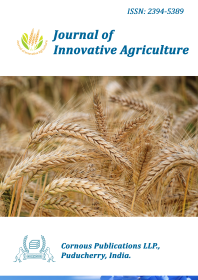
Journal of Innovative Agriculture
Peer Reviewed Open Access Journal
ISSN: 2394-5389 NAAS: 4.05
Submit Manuscript
Peer Reviewed Open Access Journal
ISSN: 2394-5389 NAAS: 4.05
Submit ManuscriptThis paper examined the strengths, weaknesses, opportunities, and threats to new technologies adoption and application in representative sub-humid agricultural communities of Irbid, Madaba, and Karak of Jordan. This is predicated on the need for improved performance and reinvigoration of research tools for better policymaking. Some of the strengths are saving time, increase production, and profitability for new technologies. The study explored socio-economic conditions of pulses farmers to evaluate the impacts of the introduction of new technologies of seeder use, zero-tillage, new pulses varieties, adding fertilizers with scheduling, using herbicides, using recommended seeding rates, and recommended planting dates. On the other hand, opportunities that can be explored is expected increased incomes. No problems or threats expected to the adoption and application of new technologies. The paper recommends that research and policymakers should pay proper attention to the strengths, weaknesses, opportunities, and threats to adoption and application of new technologies with a view of making decisions truly more responsive to local concerns and policy.
adoption, pulses, SWOT, technologies, sub-humid
Al Hiary, M. (2014). Characterization of the Socioeconomic Conditions, Full Package, and Adoption of New Technologies of Wheat Crop at Irbid Governorate, Jordan. Asian Journal of Agricultural Extension, Economics & Sociology, 605-618.
Al Hiary, M., Shakhatreh, Y., Khalaf, E. Y. B., & Maysoon, E. (2015). Socioeconomic assessment of wheat varieties and the adoption of recommended technologies in North Jordan. International Journal of Agricultural Sciences, 5(7), 864-873.
Al-Karablieh, E., & Salman, A. (2016). Water resources, use and management in Jordan. A focus on groundwater. IWMI Project Report: Groundwater governance in the Arab world. No.11, 41-42
Department of Statistics, 2017. Survey. Agriculture. DOS website, Government of Jordan.
Massimi, M. (2017). Importance of field extension training for farmers of alfalfa (Medicago sativa L.) to adopt weed control techniques. Asian Journal of Agricultural Extension, Economics & Sociology, 1-7.
Massimi, M. A., & Al-Bdour, A. I. (2018). A Short Scientific Note on the Horticultural Crops Optimum Planting Dates in Jordan. Egyptian Journal of Horticulture, 45(2), 337-340.
Massimi, M., Haseeb, M., & Rahma, N. A. (2019). Why Using Organic Fertilizers and Biopesticides is Important for Food Legumes Production in Jordan. Advances in Environmental Biology, 13(1), 38-41.
Moustafa, A. T., Jabarin, A., Jarrar, A., Jayyousi, A., Aycicegi, A. L., Yolles, D., ... & Kühn, M. (2007). Salinity management in dry regions: Fundamentals and experiences from Egypt, Israel, Jordan and the Palestinian Authority. Ramallah: Middle East Regional Agricultural Programme.
Tripathi, R. S., Raju, R., & Thimmappa, K. (2013). Impact of zero tillage on economics of wheat production in Haryana. Agricultural Economics Research Review, 26(347-2016-17080), 101-108.
